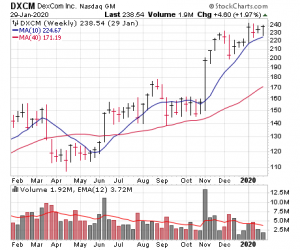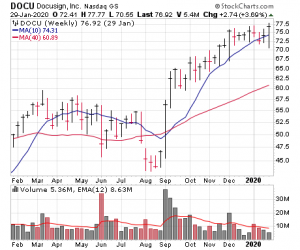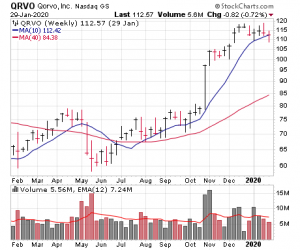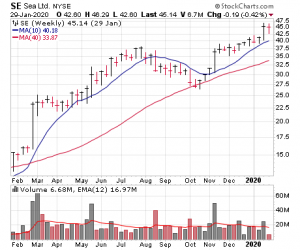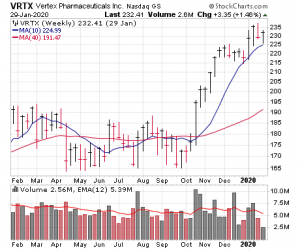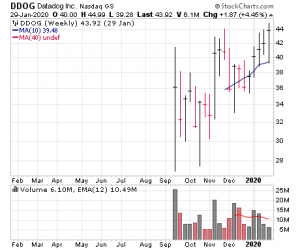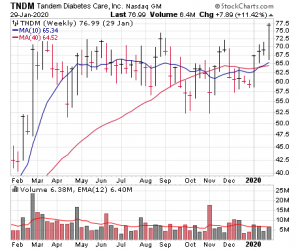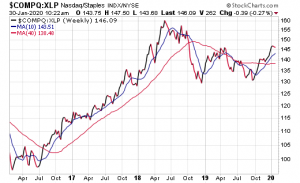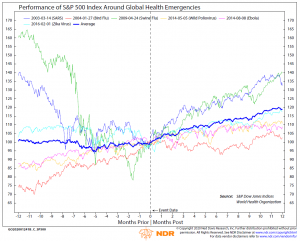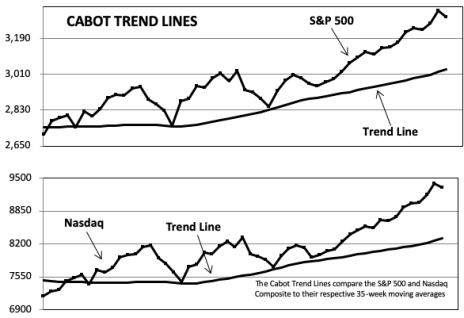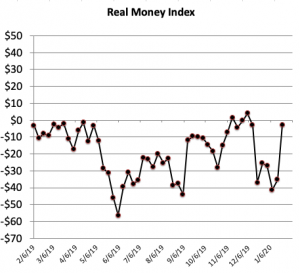The long-awaited pullback appears to have arrived, with fears and uncertainty surrounding the coronavirus and its impact on economic growth bringing out the sellers; our Cabot Tides, in fact, are now on the fence. In the near-term, the odds favor some more pain being dished out, not necessarily because of the virus, but as the market consolidates its strong four-month advance. Big picture, though, this is still a bull market, so while we’ve trimmed a bit, we’re aiming to hold our strong, profitable stocks, thinking higher highs are likely once this pullback does its work.
In the Model Portfolio, we took partial profits on DocuSign and ProShares S&P 500 Fund earlier this week, which lifted our cash position to around 20%. And from here, we’ll just take it as it comes, as we explain in tonight’s issue.
Cabot Growth Investor 1438
[premium_html_toc post_id="196642"]
A Bull Market Breather
Despite a huge run and many signs that risk was elevated, the market was doing a great job shrugging off some high-profile worries in January (Iran, impeachment), soaring to new highs day after day. But the coronavirus and its potential impact on Chinese (and global) economic growth finally caught up to the bulls—over a two-day stretch, the Nasdaq fell nearly 4% from high to low, and after a quick bounce, today brought more volatility as big investors cut back.
So far, of course, there’s no reason to panic—in fact, earnings season has been relatively encouraging thus far, and most leading stocks we own and are watching are still acting normally, if not holding near their highs. Plus, as we write about later in this issue, health scares of the past couple of decades haven’t had any long-lasting market impact (if anything the market tends to do well once the situation stabilizes), which goes along with our still-bullish longer-term indicators (Cabot Trend Lines, many positive longer-term studies).
However, when looking at the here and now, the picture isn’t quite as bright. While we’d be happy to see the market simply kite higher following a few days of shakeout-type action, the evidence for the near-term has turned mixed. Today’s action puts our Cabot Tides on the fence, as broader market indexes (small- and mid-caps, etc.) look ragged, and not surprisingly, the number of stocks making new highs has dried up markedly.
Plus, beyond specific indicators is simple common sense. Following such a big advance that brought a bunch of signs of complacency and even some giddiness, a consolidation/correction of a few weeks would be totally normal and healthy in the grand scheme of things. Simply put, it usually takes more than just a few days for a bull market to take a breather.
Put it all together, and we think it’s best to follow our normal correction/consolidation playbook: Hold a little cash, and then take things on a stock-by-stock basis—meaning trimming laggards or large positions and tightening stops on weak performers, but on the flip side, holding on tightly to resilient performers and keeping your eyes open to potential buying opportunities. We did just that earlier this week, and will adjust as need be going forward.
What to Do Now
We came into this week with around 11% in cash, but we went ahead and boosted that to 20% by taking two partial profits—selling one-third each of DocuSign (DOCU) and ProShares Ultra S&P 500 Fund (SSO), while also placing Qorvo (QRVO) on Hold. From here, we’ll just take our cue from the market and leading stocks, but we’re standing pat tonight.
Model Portfolio Update
While the market has hit a pothole, not much has really changed with individual leading stocks—don’t get us wrong, most have been dented, but very few have broken key support and some are holding right near their highs.
As we wrote on page 1, the odds favor further reverberations after such a strong advance and initial pothole; we’re happy to be proven wrong on that, but it usually takes time for investors to hedge, trim and generally de-risk. Because of that, we did some trimming of our own this week, taking partial profits in both DOCU and SSO, leaving us with around 20% in cash.
That said, we’re not eager to raise more cash—and should some good opportunities emerge during earnings season, we could take a swing at them. Tonight, though, we’re content to give the market and leading stocks a bit of room to show their hand.
Current Recommendations
Dexcom (DXCM 238)—DXCM didn’t spike with the market during the middle part of January, but it also hasn’t taken much a hit during the recent pullback—all in all, shares are chopping around in the 225 to 240 range as investors await the upcoming earnings report (due February 13). While a big part of this company’s story is obviously its own products and execution, perhaps an even larger part is the entire industry: Thanks to a wave of innovation, diabetics are shifting away from multiple daily injections and toward continuous glucose monitors (or pumps that use them), and that trend has a long way to go—just 40% or so of Type 1 (and fewer Type 2) diabetics use a CGM, but that’s quickly changing due to the benefits of keeping glucose levels within the normal range. Thus, we have high hopes that this stock’s best days are ahead of it, but as usual, we’ll just take it as it comes. With the stock acting well here, we’ll stay on Buy; the next big event is earnings, which are due out February 13. BUY.
DocuSign (DOCU 79)—We trimmed our position in DOCU this week (selling one-third of our shares) when the market began to pull in for the simple reason that it was the “weakest” stock in the portfolio—it wasn’t falling apart, but shares had been stunted since early December even as the market was flying higher. But now it looks like Monday may have been a shakeout! The stock has rebounded beautifully in the days since, nosing to new price highs (though the RP line hasn’t quite done the same), so we’re aiming to give our remaining shares some room to maneuver, especially as nothing has changed with the underlying story. Further strength from here would cause us to restore a Buy rating, but for the moment, we’ll stay on Hold as most stocks that have tickled new high ground of late have quickly seen sellers arrive. HOLD.
Inphi (IPHI 79)—Inphi has released its new Capella SerDes IP solution for data center environments, which promises better performance and lower power consumption in data centers and AI-powered devices. That’s not a game changer, but these new products will only help as big players upgrade their networks—and as the leading provider of all sorts of high-speed interconnects, Inphi should obviously benefit. The stock has taken on some water in recent days with most chip and networking names, but it continues to act fine, holding above its 50-day line and its prior high (both near 76). That said, earnings are due out next Tuesday (February 4), and that will probably tell the intermediate-term tale. We’ll stay on Buy, but keep new positions small this close to the report. BUY.
ProShares Ultra S&P 500 Fund (SSO 155)—SSO was the second position we trimmed earlier this week, booking partial profits after the market’s heady run since early October. Even after selling one-third of our shares, we still have a good-sized position (around 10% of the portfolio), so don’t mistake the partial sale with a new, darker outlook on the overall market—we’re still bullish, but now that we’ve finally seen some selling, the odds do favor further near-term ups and downs. Just as with any stock that’s had a big run from a long-term breakout, we’d expect SSO’s first pullback toward its 50-day line (now near 149 and rising) to bring in support, though we’ll see how it goes. If you don’t own any SSO and really want in, we’re not going to argue with a nibble here or on dips. But officially, we’ll keep our Hold rating in place following our trimming earlier this week. HOLD.
Qorvo (QRVO 111)—Qorvo reported a terrific quarter last night, though the market’s wobbles (and fears over the coronavirus) brought out sellers despite the good news. As for the report, sales and earnings crushed estimates thanks to the 5G ramp, and management significantly raised estimates—it’s now looking for $820 million in revenue in the current quarter (the prior estimate was $730 million!) with earnings of $1.55 per share (estimate was $1.15). Just as important, Qorvo remains very well positioned to benefit as the 5G boom picks up steam thanks to wins at most major smartphone firms and increased content per phone. That said, big investors took the stock’s initial post-earnings pop this morning as an opportunity to sell, probably because of fears (despite the guidance) that the virus will crimp demand (and possibly output) from China in the months ahead. The end result was a huge reversal today that saw QRVO close lower on big volume, finishing in the lower end of its recent trading range. Bigger picture, today’s action isn’t necessarily a death knell—there’s still plenty of support in the low 100s and the stock’s long-term chart is fine. But we’re not complacent, either, so we’ll be using a mental stop in the 105 area (just above our cost) in case perception changes. Hold for now. HOLD.
Sea Ltd. (SE 46)—Sea remains one of our stronger stocks, actually coming close to tagging new highs yesterday. The big upgrade last week (Goldman put the name on its “conviction list” and talked positively about the company’s e-commerce potential) got the juices flowing, though a small acquisition announced this week is also helping perception—the firm’s digital entertainment arm bought Phoenix Labs, a Canadian firm that operates Dauntless, a video game that was launched last May (for the major game consoles; mobile launch is this year) and now has more than 20 million users. The purchase will diversify Sea’s gaming business, which today is hugely dependent on Free Fire, and also bring with it a highly thought-of development team. As for the stock, SE is clearly extended to the upside (the 50-day line is around 39.5), but we like its resilience and volume clues in recent days. We’ll stay on Buy, though dips of a couple of points will provide better opportunities. Earnings are likely out in late February. BUY.
Teladoc (TDOC 104)—TDOC took a sharp two-day hit with the market, but that came after a monster run following the announcement of its acquisition of InTouch two weeks back. And shares rebounded quickly, notching new highs yesterday! We’ve fielded a couple of questions surrounding the firm’s bottom line, which remains drenched in red ink, and whether that will eventually catch up to the stock. It’s not ideal, but we’re thinking big investors will remain willing to pay up for the hands-down leader in what appears to be a massive opportunity—said another way, Teladoc looks like an emerging blue chip as telehealth goes from novelty to mainstream in the years ahead, and that’s keeping mutual funds in accumulation mode. (615 funds owned shares at the end of September, up from 529 a year before.) We’ll stay on Buy, but as with most stocks, look to buy on normal weakness. Earnings are likely out in late February. BUY.
Vertex Pharmaceuticals (VRTX 230)—VRTX has been pretty low on drama, with mostly calm and collected moves as it works its way higher. Impressively, since kicking off in October following the earlier-than-expected approval of Trikafta, the stock has risen on above-average weekly volume six times, vs. just one week of above-average volume selling, a clear sign that big boys and girls are picking up shares. Of course, that can all change, and we’ll obviously be watching the stock’s reaction to earnings tonight—analysts are looking for revenues of around $1 billion and earnings of $1.20 per share, but likely more important will be updates on the initial sales of Trikafta and the outlook for 2020. Of course, we’re open to anything, but there shouldn’t be much standing in the way of a surge in earnings during the next few years (especially the next two) as Vertex’s cystic fibrosis treatments gain acceptance. We’ll stay on Buy but will be on the horn after earnings if something changes. BUY.
Watch List
- Alibaba (BABA 208): BABA flashed a little abnormal weakness this week due to the coronavirus, but we don’t think it’s all over—some steadying going forward could reveal a decent entry point.
- Coupa Software (COUP 166): Cloud stocks are showing relative strength so far in 2020, and COUP was one of the first to hit new highs. We’re looking for another show of strength to tell us big investors are piling in.
- Datadog (DDOG 47): Application performance management and infrastructure monitoring don’t roll off the tongue, but they’re big growth areas as most firms adopt the cloud. See more below.
- Tesla (TSLA 646): We continue to think TSLA’s first “real” pullback or multi-week consolidation will provide a good entry point, and we’re waiting patiently for that opportunity. Earnings blew away expectations and earnings estimates are going through the roof.
- Zillow (Z 48): After a year and a half of ups and downs, Z seems to have changed character as more big investors believe its home buying (and selling) segment will be a hit.
Other Stocks of Interest
Datadog (DDOG 47)—Probably the biggest trend of the past couple of years in the business sector has been the move to cloud computing, with firms of all sizes adopting various new software programs and (often customized) apps, as well as adding to their hardware (servers) assets. That’s obviously been great … but it’s created a big headache for developers and IT operations teams aiming to track the performance and reliability of all those different systems, including how they may interact with each other. Thus, a new-ish field of infrastructure monitoring and application performance management has been born, and Datadog is one of the leaders—it believes it has the top real-time monitoring and analytics platform, allowing firms to fix problems faster and innovate quicker. Management thinks it’s a whopping $35 billion opportunity, and Datadog’s metrics are very impressive: It has 9,500 customers (up 34% from a year ago), with 727 that pay six figures or more a year (up 93% from last year), and its same-customer revenue growth has been north of 30% for nine straight quarters as customers sign up for more of the firm’s products. All told, revenues are growing north of 80%, and while earnings are in the red, they’re not far from breakeven. DDOG just came public a few months back and has been typically volatile, but we like that it’s liquid ($80 million of volume per day), all of the big volume weeks have shown accumulation or support, and that the stock this week actually pushed to new highs despite the market’s bout of indigestion. Earnings are due out February 13.
Tandem Diabetes (TNDM 74)—Diabetes-related stocks remain a strong theme, and Dexcom is obviously our top pick in the group. But one of the other names we keep a distant eye on is Tandem Diabetes, which was nearly a penny stock a couple of years ago before going on a huge run as it released what many believe is the best insulin pump on the market: Dubbed the t:slim x2, it not only has better features and metrics (far smaller and lighter than the competition; has a larger touchscreen than others; uses Dexcom’s CGM; can be updated remotely), but also comes with some predictive software. For the past few years, the x2 has included what’s known as Basal-IQ technology, which predicts glucose levels 30 minutes ahead and suspends insulin delivery if insulin is getting too low. And just in December, Tandem’s next-generation Control-IQ technology was approved for use in the x2, and it works with Dexcom’s CGM to better manage insulin levels, which should only boost demand. Bigger picture, of course, the entire diabetes industry is surging as people switch from multiple daily injections, and Tandem has enjoyed a massive growth wave thanks to the x2 (90% of patients have Type 1 diabetes; about half are new pump users, with the other half converted from another pump), with revenues basically quadrupling over the past two years. The stock had a gigantic run through early 2019, but it deserved a rest and that’s what it did over a nine month stretch, with a very reasonable sideways consolidation. Just this week, though, TNDM powered to new highs, though today’s sour market pulled it back down. Even so, it seems like it wants to go higher if the market stabilizes. Earnings are due out February 24.
Tempur Sealy (TPX 93)—Mattresses, bedding and pillow products certainly aren’t the items that tug at growth stock investors’ heartstrings, but Tempur Sealy looks like a special situation that can grow at surprisingly strong rates thanks to a couple of company-specific initiatives. The first positive is that the company is moving into direct-to-consumer sales both through new store openings (it has 50 now and thinks it can grow that to 125 to 150 over time) and e-commerce—in Q3, direct sales in North America boomed 37% even after excluding the acquisition of Sleep Outfitters, while they lifted 18% overseas, and there’s no sign of those figures slowing down. The second catalyst was last year’s game-changing distribution pacts with Big Lots (1,400 stores, some of which already sold Temper Sealy products) and Mattress Firm (2,500 stores, the largest specialty mattress retailer in North America, which wasn’t a customer) that’s expected to boost cash flow by 20% on its own! Throw in some secondary positives (tariffs were implemented on certain bedding products from China; new products are capturing market share; an improving housing market should help demand) and Wall Street is expecting a very solid 2020—analysts see revenues up around 15%, while earnings gain 45%, both of which are likely low given that the company usually trashes estimates. As for the stock, TPX isn’t a huge mover, but the price/volume action has been superb, and after hanging out for six months, shares have enjoyed some big-volume buying this week. Earnings are due out February 13.
Watch Our Aggression Index for Intermediate-Term Clues
The vast majority (call it 80%) of our market timing comes from rubber-meets-the-road evidence, specifically our Cabot Trend Lines and Cabot Tides (which give specific buy and sell signals) and the action of leading growth stocks (admittedly more subjective, but gives you a great picture of the environment). However, we also like to “fill out” our view with some secondary indicators that can give us an idea of what may come or give insight into the type of environment.
One set of measures we’ve been growing fonder of is something we wrote about back in early October—comparing the performance of a growth-oriented measure (such as the Nasdaq) to an index of safe, defensive stocks (such as the Consumer Staples Fund, or XLP). We’re calling it the Aggression Index (at least until we come up with a snazzier name), as it tells us how aggressive big investors are positioning their portfolios.
While it doesn’t work perfectly (nothing does), the Aggression Index has done a very good job over the past few years telling us when growth stocks were in favor, and when it was time to be choosier.
Shown here is the weekly chart of the ratio of the Nasdaq to XLP, along with its 10-week and 40-week moving averages. Similar to the rules on our Cabot Tides, when the ratio is above the lower of the two moving averages, and that average is itself rising, growth stocks are in favor. When the ratio dives below the lower of the two, it’s a “sell” signal.
You can see the growth stock environment turned favorable in July 2016 and stayed in gear until October 2018—just as growth stocks and everything else fell off a cliff. That long, positive phase was a great period for growth titles, with many new leaders enjoying big multi-month runs.
The Aggression Index gave a fresh green light right near the start of 2019 as the market turned up, and stayed positive through April before things turned trickier; the indicator was negative throughout the market’s five-month consolidation last year, when many growth stocks went splat. But it turned positive around Halloween (when the blue 10-week line turned up) and has been positive ever since, corresponding with boom times for most growth titles.
Now that the market has wobbled a bit, we’ll be interested to see how the Aggression Index acts going forward. A decisive break below the 10-week line could tell us a more defensive-oriented environment has arrived, but so far, the green light remains in place; as long as that is the case, growth stocks should continue to dominate the market’s leadership ranks.
The Obvious Rarely Causes Big Moves
As we’ve written elsewhere in this issue, the coronavirus-induced selloff probably has more in store in the short term, but that’s more due to the huge four-month run the market’s enjoyed than the economic damage the virus itself is causing. (That’s not to downplay the severity of the virus—if you’re near the outbreak, stay safe!) The market was at risk of a pullback and rest period, and it appears one has arrived.
Still, the fact that the virus has become so obvious to the crowd—it’s the lead story on every financial and many national news shows—is probably a sign that the damage won’t get out of hand. Simply put, the obvious rarely causes big, sustained moves in the market.
For an example, here’s a great chart showing the S&P 500’s performance before and after a series of major health scares during the past couple of decades—the bold blue line is the average performance, and the dotted vertical line is the point at which the World Health Organization (WHO) declared a global health emergency. (Hat tip to Ed Clissold of Ned Davis Research for the chart—you can follow him @EdClissold on Twitter.)
In fact, the WHO declared just such a health emergency today. And you can see that, following such a declaration, the S&P was up nearly 20% a year later! To be clear, we’re not necessarily predicting such a move, and again, the near term is likely to see some reverberations, both in the market and with the global economy.
But the larger point is that, at least based on history, high-profile, obvious health (or other) scares rarely impact the market longer-term.
Cabot Market Timing Indicators
After a very strong run, it appears that the long-awaited pullback has finally arrived, and our Cabot Tides (and other factors) tell us more pain is likely, near-term. However, it’s still very much a bull market, so we’re aiming to hold our resilient stocks and looking for new leaders that emerge on earnings.
Cabot Trend Lines: Bullish
Our Cabot Trend Lines came into this week very positive (but also very extended) to the upside, with the S&P 500 (by 8.6%) and the Nasdaq (by 12.0%!) miles above their respective 35-week moving averages. Those figures have come down a bit, but overall, this plays into the view that, near-term, some more wobbles are possible, though there’s no doubt the overall bull market is in fine shape.
Cabot Tides: On the Fence
Our Cabot Tides are on the fence after today’s action—while the S&P 500 (daily chart shown here) still has some daylight above its lower (50-day) moving average, other indexes (like small- and mid-caps) are at or below their 50-day lines. The next few days will be telling, but looking at it today, the intermediate-term trend is effectively neutral.
Cabot Real Money Index: Neutral
Our Real Money Index popped back into neutral territory as a huge one-week (seasonal-related) outflow in December fell off the five-week moving average. Still, the overall trend of money mostly coming out of equity funds and ETFs continues, and we’ll be interested to see how investors reacted to the recent market dip—any stampede out of funds could be a hint that the downside will be well contained.
Charts courtesy of StockCharts.com
The next Cabot Growth Investor issue will be published on February 13, 2020.
Cabot Wealth Network
Publishing independent investment advice since 1970.
CEO & Chief Investment Strategist: Timothy Lutts
President & Publisher: Ed Coburn
176 North Street, PO Box 2049, Salem, MA 01970 USA
800-326-8826 | support@cabotwealth.com | CabotWealth.com
Copyright © 2020. All rights reserved. Copying or electronic transmission of this information is a violation of copyright law. For the protection of our subscribers, copyright violations will result in immediate termination of all subscriptions without refund. No Conflicts: Cabot Wealth Network exists to serve you, our readers. We derive 100% of our revenue, or close to it, from selling subscriptions to its publications. Neither Cabot Wealth Network nor our employees are compensated in any way by the companies whose stocks we recommend or providers of associated financial services. Disclaimer: Sources of information are believed to be reliable but they are not guaranteed to be complete or error-free. Recommendations, opinions or suggestions are given with the understanding that subscribers acting on information assume all risks involved. Buy/Sell Recommendations: All recommendations are made in regular issues or email alerts or updates and posted on the private subscriber web page. Performance: The performance of this portfolio is determined using the midpoint of the high and low on the day following the recommendation. Cabot’s policy is to sell any stock that shows a loss of 20% in a bull market or 15% in a bear market from the original purchase price, calculated using the current closing price. Subscribers should apply loss limits based on their own personal purchase prices.


